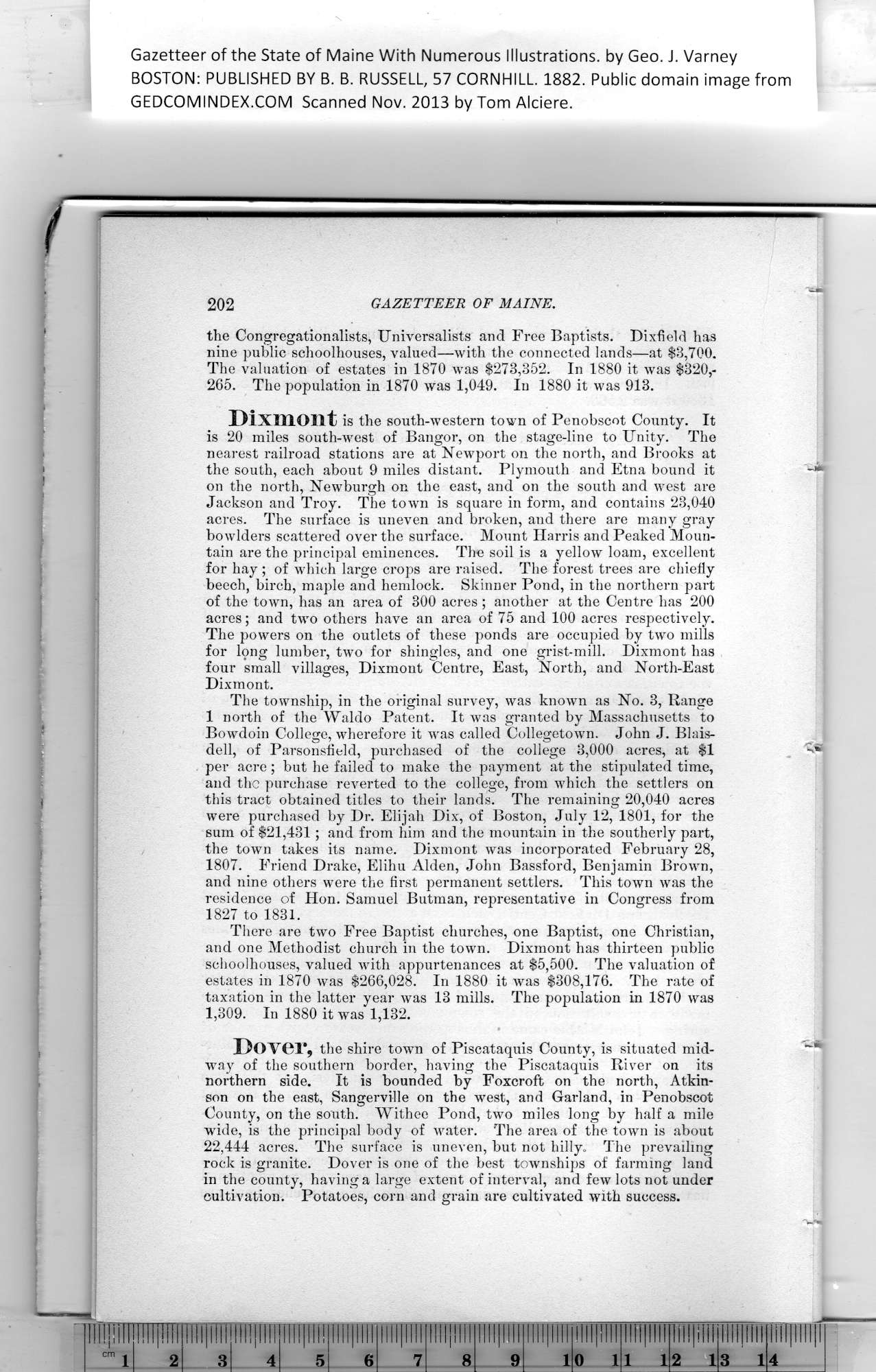|
Gazetteer of the State of Maine With Numerous Illustrations, by Geo. J. Varney
BOSTON: PUBLISHED BY B. B. RUSSELL, 57 CORNHILL. 1882. Public domain image from
202 GAZETTEER OF MAINE.
the Congregationalists, Universalists and Free Baptists. Dixfield has
nine public schoolhouses, valued—with the connected lands—at $3,700.
The valuation of estates in 1870 was $273,352. In 1880 it wTas $820,-
265. The population in 1870 was 1,049. In 1880 it was 913.
Dixmont is the south-western town of Penobscot County. It
is 20 miles south-west of Bangor, on the stage-line to Unity. The
nearest railroad stations are at Newport on the north, and Brooks at
the south, each about 9 miles distant. Plymouth and Etna bound it
on the north, Newburgh on the east, and on the south and west are
Jackson and Troy. The town is square in form, and contains 23,040
acres. The surface is uneven and broken, and there are many gray
bowlders scattered over the surface. Mount Harris and Peaked Moun-
tain are the principal eminences. The soil is a yellow loam, excellent
for hay ; of which large crops are raised. The forest trees are chiefly
beech, birch, maple and hemlock. Skinner Pond, in the northern part
of the town, has an area of 300 acres; another at the Centre has 200
acres; and two others have an area of 75 and 100 acres respectively.
The powers on the outlets of these ponds are occupied by two mills
for long lumber, two for shingles, and one grist-mill. Dixmont has
four small villages, Dixmont Centre, East, North, and North-East
Dixmont.
The township, in the original survey, was known as No. 3, Range
1 north of the Waldo Patent. It was granted by Massachusetts to
Bowdoin College, wherefore it was called Collegetown. John J. Blais-
dell, of Parsonsfield, purchased of the college 3,000 acres, at $1
per acre ; but he failed to make the payment at the stipulated time,
and the purchase reverted to the college, from which the settlers on
this tract obtained titles to their lands. The remaining 20,040 acres
were purchased by Dr. Elijah Dix, of Boston, July 12, 1801, for the
sum of $21,431; and from him and the mountain in the southerly part,
the town takes its name. Dixmont was incorporated February 28,
1807. Friend Drake, Elihu Alden, John Bassford, Benjamin Brown,
and nine others were the first permanent settlers. This town was the
residence of Hon. Samuel Butman, representative in Congress from
1827 to 1831.
There are two Free Baptist churches, one Baptist, one Christian,
and one Methodist church in the town. Dixmont has thirteen public
schoolhouses, valued with appurtenances at $5,500. The valuation of
estates in 1870 was $266,028. In 1880 it was $308,176. The rate of
taxation in the latter year was 13 mills. The population in 1870 was
1,309. In 1880 it was 1,132.
Dover, the shire town of Piscataquis County, is situated mid- "“*■
way of the southern border, having the Piscataquis River on its
northern side. It is bounded by Foxcroft on the north, Atkin-
son on the east, Sangerville on the west, and Garland, in Penobscot
County, on the south. Withee Pond, two miles long by half a mile
wide, is the principal body of water. The area of the town is about
22,444 acres. The surface is uneven, hut not hilly. The prevailing
rock is granite. Dover is one of the best townships of farming land
in the county, having a large extent of interval, and few lots not under
cultivation. Potatoes, corn and grain are cultivated with success.
PREVIOUS PAGE ... NEXT PAGE
This page was written in HTML using a program written in Python 3.2
|
